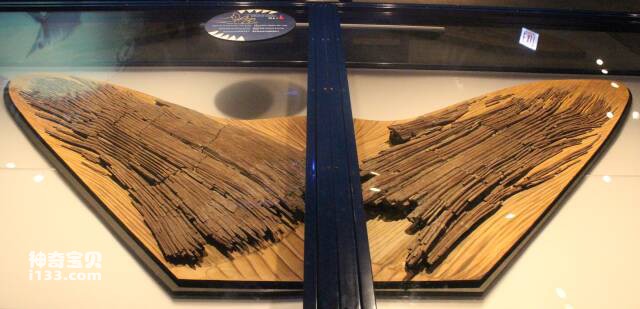99.8% of the existing vertebrates on the earth have jaws (upper jaw and lower jaw), and are collectively called jawed vertebrates or gnathostomes. The emergence and rise of jawed animals is one of the most critical leaps in the history of vertebrate evolution, "from fish to man." But when, where, and how did this jump happen? These questions require paleontological evidence to answer. Let’s first take a look at the following top ten jaw fish fossils in the world:
1. Megalodon

This is a giant shark that lived during the Miocene period from about 23 million years ago to 16 million years ago. It is classified as part of the extinct family Odontodontidae, which diverged from great white sharks during the Early Cretaceous. The megalodon is believed to be the largest large predatory shark that ever lived. Megalodon is found throughout the world; its fossils have been found in many places around the world, including Europe, Africa, the Americas, and Australia. The megalodon appears in many works of fiction, including movies and novels, and remains a popular subject for novels involving sea monsters.
2. Dunkleosteus

Dunkleosteus is a pelagic fish that lives in open waters and lived during the Devonian Period from 380 million to 350 million years ago. It is a large predatory fish with powerful jaws and sharp teeth. It is also the top predator of its ecosystem. Dunkleosteus fossils were first discovered in 1867 by paleontologist Jay Terrell, and the world's largest collection of Dunkleosteus fossils is located at the Cleveland Museum of Natural History.
3. Coelacanth

The coelacanth is a rare and ancient fish that lived 410 million years ago. It became extinct in the Late Cretaceous about 66 million years ago, and the living coelacanths belong to its descendants. The earliest coelacanth fossils were discovered in the 19th century and are considered a transitional species between fish and tetrapods. Based on analysis of annual growth marks on body weight, it is estimated that they lived up to 100 years, similar to humans, and reached maturity around 55 years old; the oldest known specimen was 84 years old in 1960. Coelacanth fossils are on display at the Senckenberg Museum of Natural History in Frankfurt am Main, Germany.
4. Xiphactinus

Sword rays lived during the Cretaceous period from 83 million years ago to 66 million years ago. It is also a giant predatory fish with sharp teeth and powerful jaws. Also voracious predatory fish, at least a dozen specimens have been collected with the remains of large, undigested or partially digested prey in their stomachs. The fossil is on display at the Sternberg Museum of Natural History in Hays, Kansas.
5. Helicoprion


Lived in the Permian period from 320 million years ago to 270 million years ago. It had a row of curved, serrated teeth and was thought to be a carnivore. Nearly all fossil specimens are spirally arranged clusters of individual teeth called "teeth" that were embedded in the jaw during life. As with most extinct cartilaginous fishes, the skeleton is mostly unknown. Fossils of the Helical tooth shark have been found around the world.
6. Leedsichthys

Lived in the Jurassic period from 150 million to 130 million years ago. It is a giant fish believed to be up to 27 meters long, making it one of the largest known fish. The Leedsfish appeared in the 2003 BBC film "The King of the Sea". A Leedsfish was hunted by a crocodile and a shark, and was finally killed by a Liopleurodon and became a feast for a group of Liopleurodon. . Pictured above is a fossilized tail fin from the Natural History Museum in London.
7. Stethacanthus

Lived in the Devonian and Permian periods from 340 million to 280 million years ago. It has strange flipper-like appendages that may be used to latch on to other animals. It has a shark-like appearance. However, it is best known for its unusually shaped dorsal fin, which resembles an anvil or an ironing board. Small spikes (enlarged versions of the dermal denticles that usually cover shark skin) cover this crest, as well as the ratfish's head.
8. Arandaspis

Lived in the Ordovician period from 430 million to 420 million years ago. It is a primitive fish with a relatively simple body shape and skull structure. The streamlined body is covered with rows of knotted armored scales. The front of the body and head are protected by hard plates with openings for eyes, nostrils, and gills. It could be a filter feeder. It has no fins; its only method of propulsion is by using its vertically flat tail. Therefore, it probably swam in a manner similar to modern tadpoles. Fossils of Arandaspis at the Natural History Museum, London.
9. Eusthenopteron

Lived in the Devonian period from 370 million to 350 million years ago. It is a famous ancient fish considered to be one of the ancestors of modern vertebrates. The earliest known evidence of fossil bone marrow is found in Euptera, which may be the origin of bone marrow in tetrapods.
10. Anomalocaris


Anomalocaris lived in the Cambrian period from 515 million years ago to 485 million years ago. It is an early arthropod with a powerful jaw structure and sharp teeth. With a body length of nearly 40 centimeters, Anomalocaris is one of the largest animals in the Cambrian period and is considered to be one of the earliest top predators. It propels itself through the water by swinging flexible flaps on its sides. Each flap slopes beneath the flap further back than it, and this overlap allows the lobes on each side of the body to act as a single "fin," maximizing swimming efficiency.
animal tags:
We created this article in conjunction with AI technology, then made sure it was fact-checked and edited by a Animals Top editor.